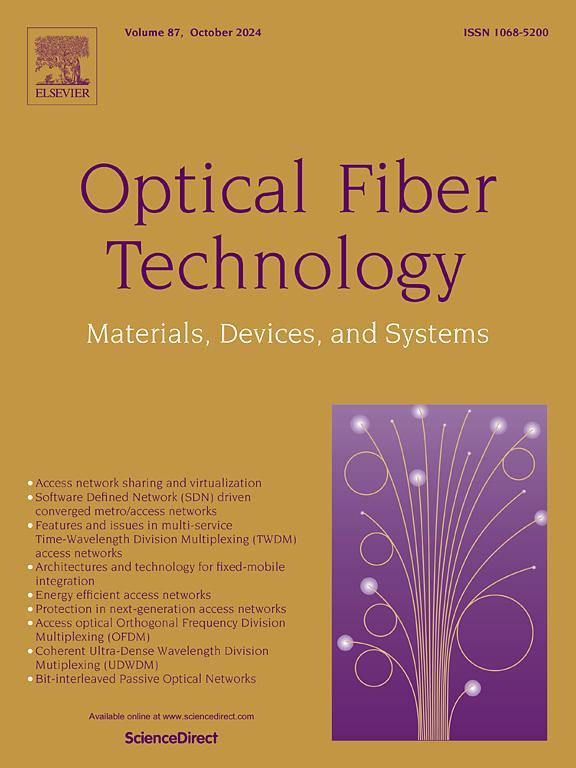ASE-induced Quasi-Cross-Excitation Transfer Process (Quasi-CETP) mechanism in Erbium–Ytterbium co-doped fiber lasers: Theoretical modeling and experimental validation
IF 2.7
3区 计算机科学
Q2 ENGINEERING, ELECTRICAL & ELECTRONIC
引用次数: 0
Abstract
The generation of high-quality seed signals at 1590 nm has been widely recognized as crucial for frequency doubling to 795 nm light required in spin-exchange relaxation-free (SERF) magnetometers. Conventional erbium-doped fiber systems face significant challenges at 1590 nm due to low gain efficiency and amplified spontaneous emission (ASE) noise, highlighting the need for advanced excitation mechanisms. However, the lack of a detailed understanding of internal ASE-mediated excitation pathways has hindered the development of efficient laser sources with high gain and signal-to-noise ratio (SNR) in this spectral region. In this work, we investigate a novel ASE-induced quasi-cross-excitation transfer process (quasi-CETP) in erbium–ytterbium co-doped fiber (EYDF) systems. A coupled rate equation model is developed to capture ASE spectral evolution and its impact on population dynamics. The model reveals characteristic nonlinear spectral features and identifies three operational regimes — gain, quasi-saturation, and degradation — based on fiber length. Experimental validation using a pump-recycling-assisted distributed feedback (DFB) fiber laser confirms the model and demonstrates a high-quality 1590 nm seed with enhanced signal-to-noise ratio and spectral purity, offering a stable source for frequency doubling and quantum sensing applications.
铒镱共掺光纤激光器中ase诱导的准交叉激发转移过程(准cetp)机制:理论建模和实验验证
在1590 nm处产生高质量的种子信号已被广泛认为是自旋交换无弛豫(SERF)磁力计所需的频率加倍到795 nm光的关键。传统的掺铒光纤系统在1590 nm处由于低增益效率和放大的自发发射(ASE)噪声而面临重大挑战,这突出了对先进激发机制的需求。然而,缺乏对内部ase介导的激发途径的详细了解阻碍了在该光谱区域具有高增益和信噪比(SNR)的高效激光源的发展。在这项工作中,我们研究了在铒镱共掺光纤(EYDF)系统中一种新的ase诱导的准交叉激发转移过程(准cetp)。建立了一个耦合速率方程模型来描述ASE光谱演化及其对种群动态的影响。该模型揭示了典型的非线性频谱特征,并根据光纤长度确定了增益、准饱和和退化三种运行机制。使用泵浦回收辅助分布式反馈(DFB)光纤激光器进行的实验验证证实了该模型,并展示了高质量的1590 nm种子,具有增强的信噪比和光谱纯度,为倍频和量子传感应用提供了稳定的源。
本文章由计算机程序翻译,如有差异,请以英文原文为准。
求助全文
约1分钟内获得全文
求助全文
来源期刊

Optical Fiber Technology
工程技术-电信学
CiteScore
4.80
自引率
11.10%
发文量
327
审稿时长
63 days
期刊介绍:
Innovations in optical fiber technology are revolutionizing world communications. Newly developed fiber amplifiers allow for direct transmission of high-speed signals over transcontinental distances without the need for electronic regeneration. Optical fibers find new applications in data processing. The impact of fiber materials, devices, and systems on communications in the coming decades will create an abundance of primary literature and the need for up-to-date reviews.
Optical Fiber Technology: Materials, Devices, and Systems is a new cutting-edge journal designed to fill a need in this rapidly evolving field for speedy publication of regular length papers. Both theoretical and experimental papers on fiber materials, devices, and system performance evaluation and measurements are eligible, with emphasis on practical applications.
 求助内容:
求助内容: 应助结果提醒方式:
应助结果提醒方式:


